
The Most Common Chilli Pepper Pests & Diseases
Cultivating chilli pepper plants is not just about watering and feeding them; you must be prepared to tend to them when they're sick too! This guide will help you identify and treat the most common ailments your chilli plants could contend with, making your growing life happier.
Growing plants, be it cannabis, sunflowers, or chilli peppers, is good for the mind, body, and soul. Chilli pepper plants are among the easiest and most rewarding to grow, allowing you to spice up your culinary life and learn a lot about horticulture in the process.
Part of cultivation is learning to avoid, identify, and rectify bacterial, viral, fungal, and insect infestations. This guide will show you some of the most common infestations and infections likely to occur in a chilli pepper grow, and what to do about them.
Common chilli pepper bacteria and viruses
People aren’t the only things that can develop infections, and suffer as a consequence. Chilli plants can get sick too, to both their and our detriment. A sick chilli plant is an unhappy chilli plant, and it will not produce the generous yield we're after.
So, learning to identify and treat common chilli ailments, therefore bringing your infected plants back to full health, is a crucial skill in chilli cultivation.
Here are some of the most common.
Bacterial Spot
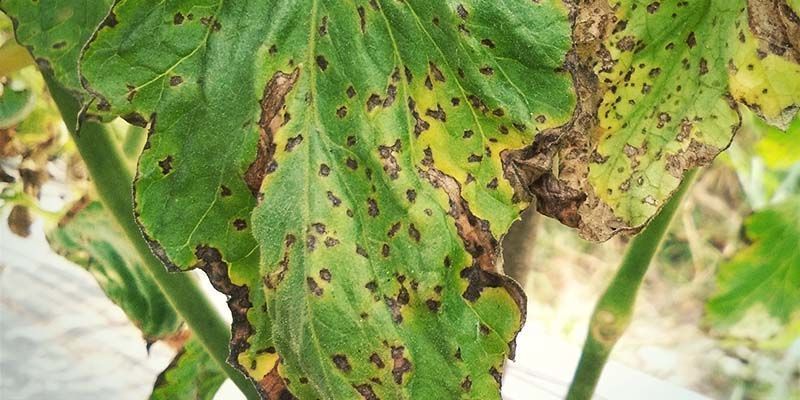
Xanthomonas campestris pv. vesicatoria causes spots to develop on the leaves and fruits of chilli (and tomato) plants. It's an aggressive infection and can be problematic. Most commonly, it is with the plant from seed, passed down from the parent plant. It is therefore essential never to grow pepper seeds that come from a plant with bacterial spot.
The upside is that good-quality seeds should hopefully be free from this infection. However, keeping levels of humidity and moisture down is another good way to keep this bacterium at bay, as, like many pests, it thrives in moisture.
Symptoms
- Depressed pits in leaves, with a black centre and yellow border growing up to ¼ of an inch
- Raised and scab-like spots on the underside of leaves
- Raised spots on chillies
- If left to persist, leaves will eventually turn yellow, wilt, and drop off
- Fruits will eventually rot
Solution
- Use good-quality seeds/clones
- Use fresh soil, or soil that you know is free from contamination
- As soon as you identify the infection, remove the infected parts of the plant
- Keep pepper plants well-fertilised (but not too much), as this will help them stay healthy and fight it off themselves
- A copper-based fungicide administered as a foliar spray is known to help defeat bacterial leaf spot
Bacterial soft rot
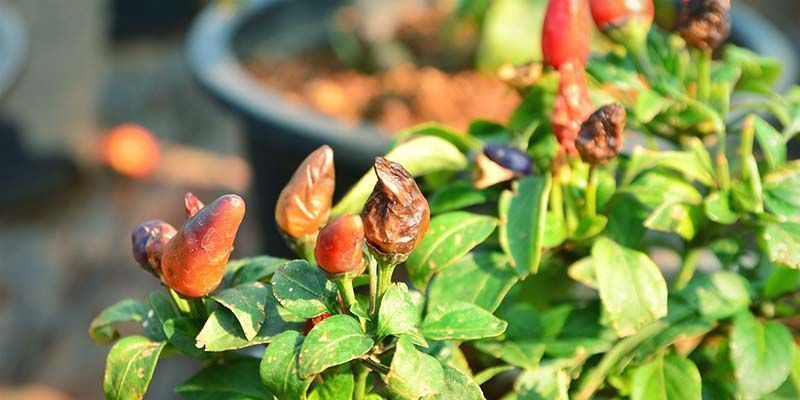
Bacerial soft rot is an infection caused by several species of bacteria: Erwinia, Pectobacterium and Pseudomonas. It affects the whole plant, but attacks the fruit most aggressively, causing them to wither and rot away. These bacteria live in the soil, thriving in wet and warm conditions. It infects the plant through wounds, either produced by breakages or pests.
This infection is not to be confused with blossom-end soft rot, which is caused by a calcium definciency. These two ailments can look similar, with the fruits appearing to rot away. They are, however, quite different, and of differing severity.
Symptoms
- Darkening veins and necrosis on leaves
- Wet, sunken lesions on leaves, stem and fruits
- Eventually the whole fruit will become watery, rot away and drop off the plant
Solution
- Keep conditions cool and as dry as possible
- Avoid damaging your plants
- Remove parts of the plant you suspect of being infected
- Keep plants from touching one another
- Exercise hygeine
- Consider culling infected plants
Verticillium wilt
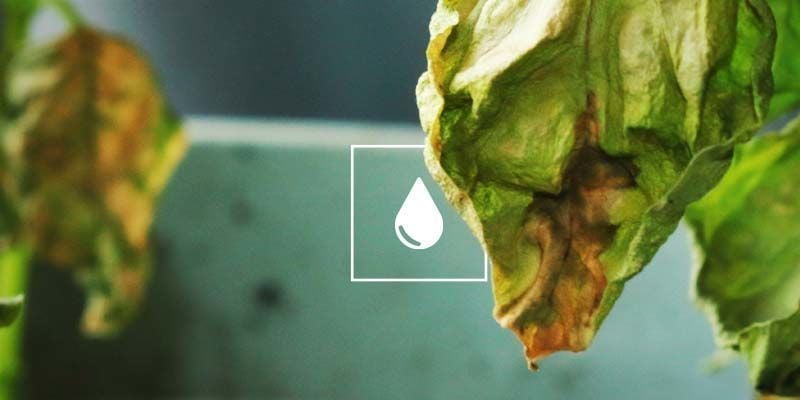
Found most commonly in areas where tobacco used to be grown, this is a problematic bacterium that can result in mass culling of crops.
Hard to distinguish quickly, this infection blocks the vessels of the plant, stopping it from transporting water around its body. Eventually, after wilting entirely, it will collapse and die. Once a plant has been identified as having verticillium wilt, it must be removed to prevent it from infecting other plants.
If you suspect your plant to be suffering from this affliction, water it and see what happens. It could just be dehydrated. If it doesn’t respond to watering, then something may be wrong.
Symptoms
- Yellowing and wilting, often beginning on one side before spreading to the other
- Internal vessels may appear brown and rotten
Solution
- Remove affected plants
- Control pests—these can take the infection from one plant to another
- Add beneficial bacteria to the soil
Tobacco etch virus (TEV) / tobacco mosaic virus (TMV)
%20_%20tobacco%20mosaic%20virus%20(TMV).jpg)
These viruses are irreversible and will result in the eventual death of your plant. Some pepper plants have a natural resistance to certain tobacco viruses, and using these is a good way to avoid this problem altogether. However, there are variations of the virus that all plants can catch.
Tobacco mosaic virus is spread mostly via "mechanical transmission", i.e. handling an infected plant and then handling an uninfected plant. So be careful if you suspect one of being infected. Tobacco etch virus can also be spread by mechanical means, as well as by sap-sucking insects, such as aphids.
Even though you will have to remove the infected plants, the fruits produced are safe to eat, and so it need not be a total loss.
Symptoms
- Green and yellow mottled leaves
- Bumpy surface on fruits
- Stunted growth
- Reduced fruit production
Solution
- Wash your hands if you suspect you’ve handled an infected plant
- Keep your plants away from weeds that can spread these viruses or harbour pests that do
- Keep pests at bay
Common chilli pepper fungi
Bacteria and viruses are by no means the only things that may seek to cause your chillies harm. Certain fungi may also decide that your chilli plants are a good place to call home. Unfortunately, it doesn’t tend to be a mutualistic relationship!
Damping off
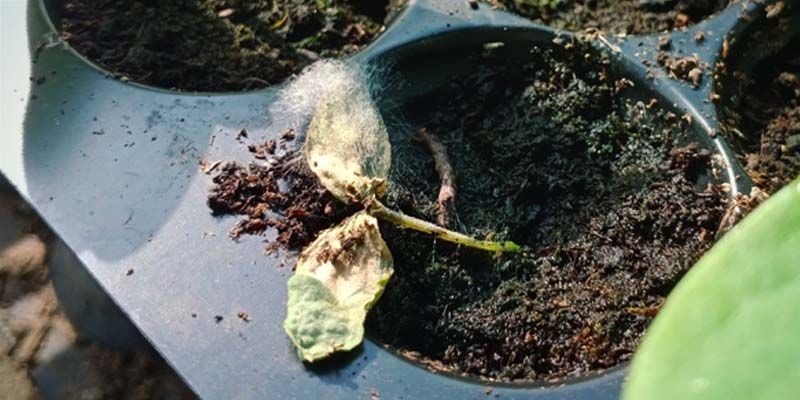
Damping off is a general term describing young plants that fall prey to any number of fungal infections, eventually leading to their demise. Most commonly, this issue will arise in damp, cool, poorly ventilated conditions.
Symptoms
- Seedlings failing to sprout at all
- Brown spots on the leaves of seedlings
- Browning on the lower stem
- Slimy and soft foliage
- Seedlings collapsing and dying
Solution
- Don’t overwater—this would just assist in the development of fungi
- Use seedling mats and grow lights to keep temperatures higher, simultaneously strengthening your plants and weakening the fungi
- Keep your hands and tools clean to stop yourself from contaminating seedlings with fungal spores
Anthracnose
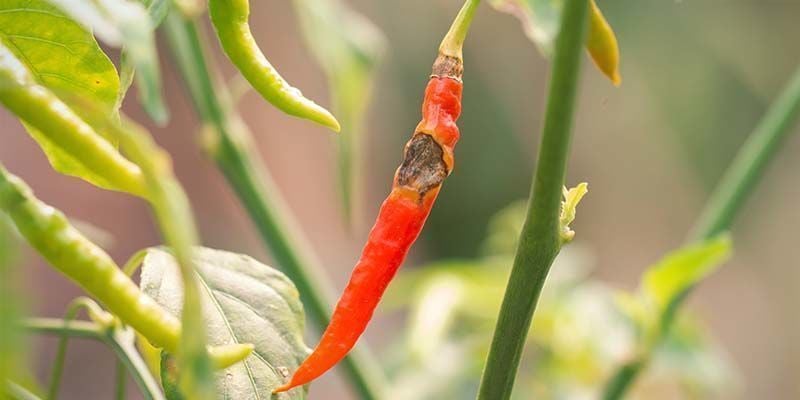
Colletotrichum piperatum and C. capsici cause this infection. Unlike some other infections mentioned here, it is not necessarily severe and can be overcome with care. Moreover, unless it gets out of hand, it should not significantly damage your crop.
It affects sweet pepper and hot chilli pepper plants equally, and finds it easiest to spread under warm, moist, and poorly ventilated conditions. So maintaining a healthy, airy environment should help to avoid it in the first place.
Symptoms
- Depressed, brown spots on fruits
- Appearance of pink or yellow spore masses
Solution
- Remove diseased fruit—this may be enough
- Use seeds from healthy plants
- If it gets severe, use a natural fungicide
Powdery mildew
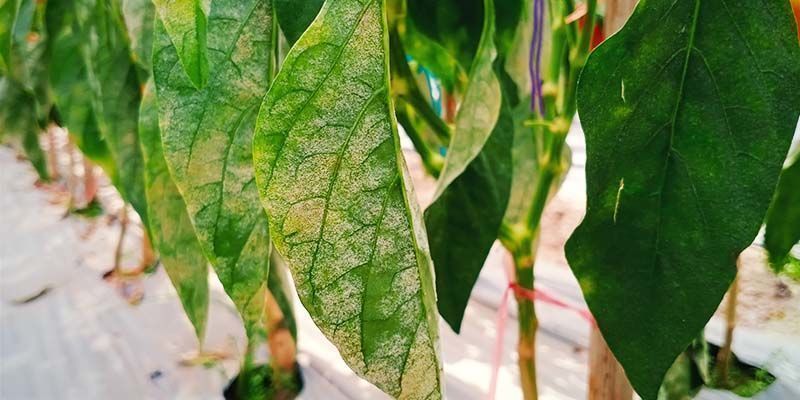
Powdery mildew is a fungal infection that is common across the plant world. Though it can be very problematic, it is also fairly simple to treat, and does not spell doom.
Caused by the fungus Leveillula taurica, it primarily affects older leaves just before or at the point of fruiting, though it can appear at any time. It spreads under warm, wet conditions.
Symptoms
- Patchy, white, powdery growth on the leaves
- Leaves will eventually drop off
- Exposed fruits may suffer from sunscald
Solution
- Ventilation is key to avoiding this issue
- Removal of infected leaves may suffice
- In some circumstances, a fungicide or foliar spray of sulphur and potassium bicarbonate should kill it off
Phytophthora blight
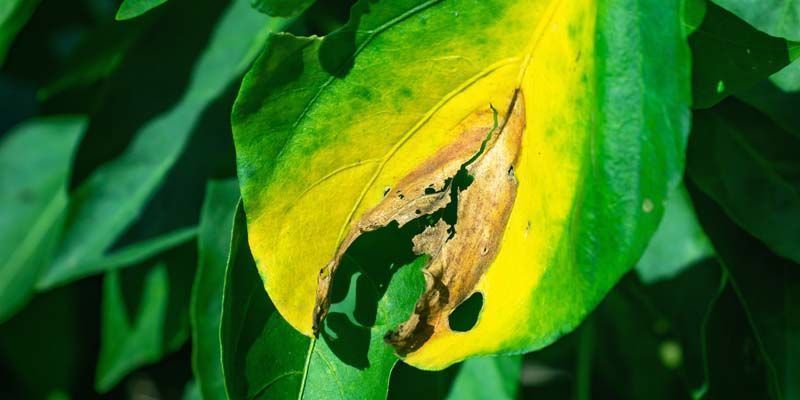
Phytophthora blight is just one type of blight, but each is similar and spreads in the same way.
These are soil-borne pathogens that can potentially kill your plants. Despite being soil-borne, they do not enter the plant via the roots, but via the lower leaves. Through rain or watering, the spores can splash up and come into contact with the lower leaves, leading to infection.
Symptoms
- Large, brown leaf spots, leading to wilting
- Brown or black growth at the base of the stem
- Root rot
- Fruit rot
- Plant death
Solution
- Plant in pots or raised beds for drainage; this pathogen is most commonly found in natural soil
- Otherwise, mound soil around the base of your pepper plant to avoid standing water
- Adding mulch around the base will also help to avoid water splashing up to the lower leaves
- Do not overwater
- Use good-quality soil
Common chilli pepper pests
Now that we’ve got different kinds of infections out of the way, we’ll look at some of the more common (and more mobile) pests that like to feast on and inhabit chilli plants.
Spider mites
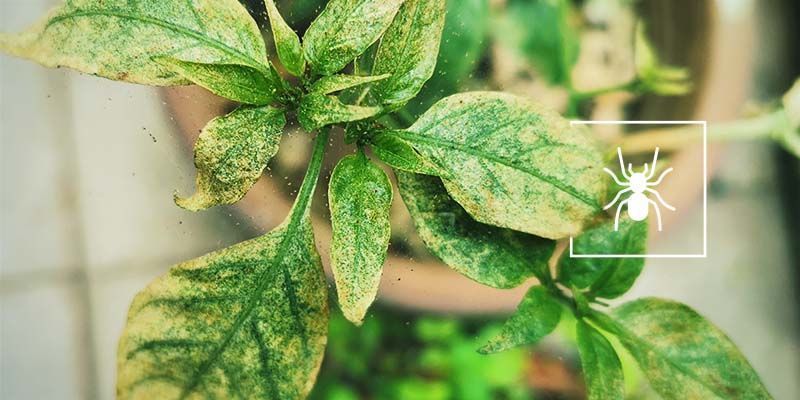
These pests live and feed on your chilli plants. Spider mites will lay their eggs on your plant, and when they hatch will begin to drain it of its nutrients. If left untreated, your plant may eventually die.
Symptoms
- Collections of eggs along the veins of leaves
- Visible pests (though they may be too small to see)
- Leaf damage or curling
- Dark spots on leaves
- Cobweb-covered parts on the plant
Solution
- Keep space between plants to stop pests from spreading
- Spray with neem oil to kill the hatched spider mites
- Ultimately, you need to deal with the eggs too, so introducing beneficial fauna might be necessary
Phytoseiulus persimilis are spider mite predators and feed on spider mites and their eggs. Once the infestation is gone, P. persimilis will starve to death. If growing outdoors, encouraging the growth of other predators, such as ladybugs, will keep all manner of pests at bay.
Pepper weevil
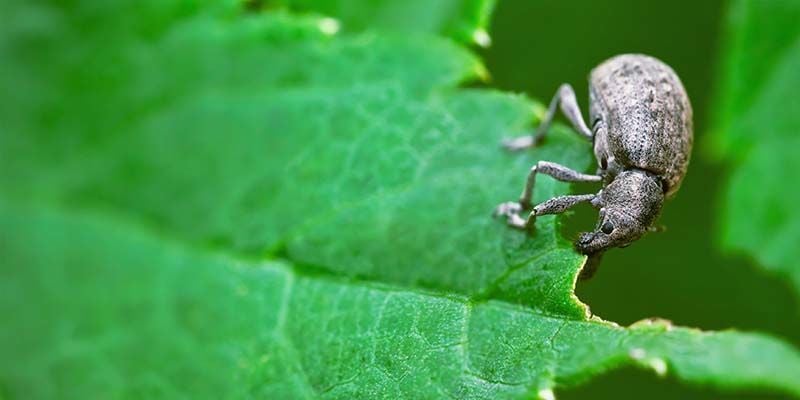
Pepper weevils are indiscriminate and aggressive in their attitude toward chilli peppers. In fact, they are thought to infest and destroy all known types of peppers, and are one of the chilli grower’s greatest fears.
The adults eat fruits and buds, boring into the calyxes and laying their eggs. Once the eggs hatch, they will eat their way through to the seeds, killing off the fruits. As they reproduce and grow quickly, they swiftly get out of hand and kill off a crop.
Symptoms
- Rotting fruit
- Rotting leaf buds
- Visible infestation
Solution
- Keep plants separated to avoid cross-contamination
- Keep plants away from other plants in the Solanaceae family, including weeds, as these may host pepper weevils
- Certain parasitic wasps are known to feed on pepper weevils, but they are not thought to be effective enough to kill off an infestation
- It’s possible (if you want to save your chillies) to use an insecticide. If you opt for this—and some would say that letting your crop die is a better option—try to use ones that cause as little damage as possible. For instance, some will not harm bees that may feed on the flowers of your chilli plants.
Pepper maggots

These are white-yellow little worms that bore inside your pods, causing them to turn red prematurely and then rot. Compared to other pests and diseases mentioned here, they are fairly benign and can be destroyed with adequate observation and action.
Pepper maggots are larval pepper maggot flies that lay their eggs on pepper plants. The fly is problematic as it lays the eggs, but it is the maggot that bores into and eats the fruits.
Symptoms
- Rotting and prematurely reddening fruit
- Boreholes in fruits
- Visible maggots
Solution
- Remove contaminated fruits
- Keep plants away from one another
- Sticky traps can attract the adult pepper maggot fly, which will stop them from laying eggs on your plants
Chilli pepper plant infestations: a worthy fear?
Many, if not most, chilli grows will proceed from seed to harvest without issue. And many more will rectify their issues themselves—plants have been developing defence mechanisms for hundreds of millions of years after all; this is why chillies are spicy!
Occasionally, though, especially in crowded, moist grows, infections and infestations will occur. Most of the time, with a little knowledge, love, and care, these can be overcome with little damage to your beloved plants. Maintaining a good environment, and regularly observing your crop, will help you prevent the very worst-case scenarios, and will get you closer to your plants in the process.
-
 5 min
24 January 2022
When And How To Harvest Hot Peppers
You've taken the time to cultivate hot peppers, giving them everything they need to flourish throughout their growing cycle. Yet, arguably the most critical moment is fast approaching; when and how...
5 min
24 January 2022
When And How To Harvest Hot Peppers
You've taken the time to cultivate hot peppers, giving them everything they need to flourish throughout their growing cycle. Yet, arguably the most critical moment is fast approaching; when and how...
-
 9 min
5 October 2021
Top 15 Hottest Peppers In The World (2025 Edition)
How does a chilli become the hottest in the world? We take a look at the 15 most potent peppers you'll want to get your hands on—or perhaps avoid, depending on how well you can handle the heat! We...
9 min
5 October 2021
Top 15 Hottest Peppers In The World (2025 Edition)
How does a chilli become the hottest in the world? We take a look at the 15 most potent peppers you'll want to get your hands on—or perhaps avoid, depending on how well you can handle the heat! We...
-
 7 min
12 August 2021
Growing Peppers For Beginners In 10 Easy Steps
Growing peppers at home can be a hugely rewarding task. Harvesting your own carefully cultivated chillies to use in cooking is a great feeling. But, from seed to harvest, how do you achieve this?...
7 min
12 August 2021
Growing Peppers For Beginners In 10 Easy Steps
Growing peppers at home can be a hugely rewarding task. Harvesting your own carefully cultivated chillies to use in cooking is a great feeling. But, from seed to harvest, how do you achieve this?...
-
 4 min
11 June 2021
Can Black Pepper Help Manage the Effects of Cannabis?
Both black pepper and cannabis contain the terpene and dietary cannabinoid beta-caryophyllene. This molecule activates the CB2 receptor of the endocannabinoid system and produces relaxing and...
4 min
11 June 2021
Can Black Pepper Help Manage the Effects of Cannabis?
Both black pepper and cannabis contain the terpene and dietary cannabinoid beta-caryophyllene. This molecule activates the CB2 receptor of the endocannabinoid system and produces relaxing and...













 United States
United States










